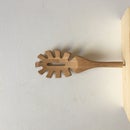Introduction: Relativity 3D Speaker Design
This speaker has a 'sound inspired design' and was made for a University project.
The design is derived from an exploration of sound through time. I was curious if an average day contained more, less or the same amount of noise that i thought it did. At hourly intervals, a 10 second sound bite was recorded and analysed for its average relative volume as compared with the recordings from the other hours. Then, each data point was represented using hemispheric cut-outs or augmentations, depending on whether the recording took place during day or night. I found that overall, a day is relatively quiet, but there was particular hours, like 4pm and 10pm which had more noise than I expected.
The shape of the speaker enclosure represents time and the passing of time. The shape is hemispheric and inspired by the shape of the planets. The top face which houses the speaker driver and contains the hemispheres representing volume throughout the day is inspired by a traditional clock face.
Step 1: Construct Geometry in CAD
Two options for integrating storage for the electrical components shown above:
1. Vertical storage
Pros: Design is simpler and more enclosed
Cons: Difficult to interface with the speaker's controls
2. Horizontal storage
Pros: more physically stable, user can access circuit controls
Cons: Need a plate to secure the board and battery, need to solder components in situ.
Step 2: Print Geometry
I used an Ultimaker 3 Extended+ with the following settings:
Wall thickness 1mm
Resolution: 0.2mm
Raft adhesion
Supports on
In a Silver PLA filament
Step 3: Assemble
Place components into the printed speaker carefully ensuring that the charging cable is accessible from the base. The speaker driver should sit flush with the top of the enclosure if the geometry.


